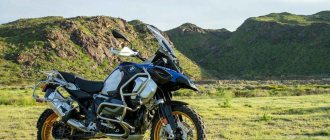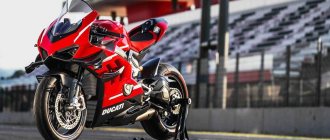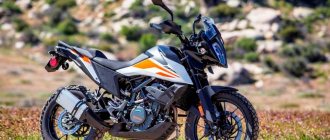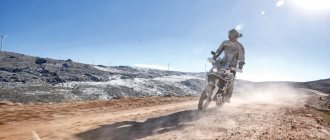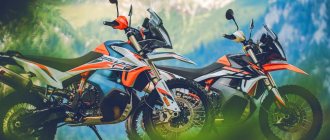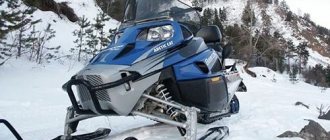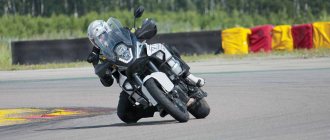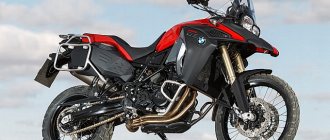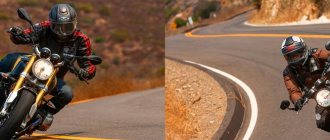KTM 1090 Adventure R 2021 and KTM 790 Adventure R 2019
In our editorial office, I am considered the main lover of touring bikes. Why? It’s just that I have a 2021 KTM 1090 Adventure R, and it’s my job to keep an eye on the news in this segment. So I spotted the KTM 790 Adventure R before it even went on sale. I have studied all the materials about this model. I saw its prototype in Germany. My colleagues even began to worry about me, whether I would collapse because of this (I then told them this: guys, don’t worry, I won’t sell the 1090, and having two orange Tourandas in the garage is a sure sign of madness). But KTM promised some damn interesting things - and I waited.
About a year after the model's launch, I finally got my hands on the KTM 790 Adventure R, and not for a fussy get-together with other journalists. The 790 lived in my garage for about 3 weeks (colleagues, by the way, were in a panic). I even had time to ride it on my lawn, and then the 1090, gave the 790 a name and began to spend a lot of time with it.
Don’t worry, self-isolation did not affect my condition at all. The point here is this: I recently got involved in an interesting project in which a couple of smart guys and I are converting Ryzhik into a KTM 790 Adventure R Rally. However, this is a slightly different story, which I will tell you about later.
In the meantime, the story will be about my first ride on the KTM 790 Adventure R. That day I called a friend, handed him the key to my 1090 Adventure R - and we set off. A friend of mine is a big fan of hard enduro and has never ridden elephants off-road, so he turned out to be an excellent impartial judge and at the same time an experienced accomplice in outrages in the mud. We swapped motorcycles all day and compared them in the same situations.
As a result, instead of a review, we got a full comparison.
Motors
The KTM 1090 Adventure R is equipped with a 1050 cc 75-degree V-twin engine that produces 125 horses and 108.5 Nm of thrust. The engine is a direct descendant of the KTM 1190 Adventure R and 1050, inheriting many components from them and acquiring a couple of its own (for example, the crankshaft and flywheel).
KTM 1090 Adventure R
The KTM 790 Adventure R borrows its entire 799cc inline-two from its brother, the 790 Duke. True, the engine on the Adventure R has been retuned for more traction and low-end power. The new KTM 790 Adventure R produces 95 horses at 8250 rpm and 89.5 Nm at 6500 rpm from the crankshaft. Compare with Duke: 105 horses at 9000 and 86.7 Nm at 8000.
Thanks to this, power is available earlier on the KTM 790 Adventure R. If the Duke is dull and sluggish until about 4500 - 5000, then the Adventure needs to be cranked up to about 3000, and it begins to hint that it could switch.
Neither the 1090 nor the 790 like to rev hard, preferring to cruise at mid-range revs, but the 1090's engine is easier to control at low speeds. The fuel map of the 790 was clearly ruled by environmentalists, and its mixture is rather lean, especially from the bottom, and the engine turns accordingly easily. So it requires more careful handling of the gas and clutch than the 1090.
Okay, to be honest, my KTM 1090 is modified from the Rottweiler catalogue, particularly the intake and fuel maps. Modern motorcycles, which must comply with Euro 5 standards, are forced to balance between ecology and performance. I believe modifications will be available for the 790 that Greenpeace will not like, but will delight riders.
KTM 790 Adventure R
We ride the KTM Adventure 1090
Again the road led me to new emotions and gave me a ride on the KTM Adventure 1090. I don’t even know where to start, with the fact that the road led first to Bike Land, or with the fact that I arrived on my 48... But the fact remains a fact, fan HD, I can barely reach the ground and look at the screen with the driving mode...
Sports, road, rain and off-road... It seems dry, I’m going to take a quiet ride around the area.. Well, of course the road... I didn’t bother going into the settings further, and so it will go. Hand protection, windshield and other utilities, well, here we go...
The sound of the engine immediately reminded me of a Ducati. Clutch, first, handle towards you. Normal, a little twitchy, feet on the pegs. The landing is good - I sit high, I can look far away. A curb, a bump, a hatch... Wow, I didn’t understand... Another bump, another hatch... You can go nuts... A bigger hole, standing on the pegs like in a video about endurists... Lightweight, perfectly balanced motorcycle.
I understood the hint. Where is the turn off from the road? The brakes are good, especially after Harley ones, but here it’s clear that they’re in a completely different class. Sand, some kind of crushed stone, grass, clearing, hummocks... Standing, faster, even faster.. How to convey emotions in words? I’m like Susanin, follow me, I’ll show you the shortcut.
The KTM 1090 Adventure produces 125 horses and 205 kilograms of net weight. After just five minutes of driving on asphalt and fifteen off the road, the avid Chepperyuga felt ready to rush onto 1090 to Vladivostok. Leaving the highway and soaking in the beauty of our vast homeland.
The sensations are comparable to those after purchasing the Jeep Wrangler 4.0. I just stopped thinking “will I get through or not?” I stopped clearing the snow from my car in winter, and I don’t wash my car often in the warm season. What for? For those who do not participate in competitions and do not stir up dirt, there is no need to ask such questions, just as there is no need to wash the KTM too often. After all, there are more interesting things...
The time of sports tourers is passing and the era of touring-enduros like this one, like the BMW GS, Ducati Multistrada and Triumph Explorer, is coming. Each has its own characteristics, each has its own approach, but they are all made for one thing - to travel without limiting yourself.
He rarely travels around the city and doesn’t go to the turnout, doesn’t know the opening and closing dates of the motorcycle season, doesn’t know the biker scene or gas stations with delicious coffee. But he remembers very well that cafe on the highway, between Omsk and Tyumen, where he warmed up after two frosty days in the pouring rain. It has good textile equipment, windproof and waterproof, with linings and ventilation. He services his KTM himself, everything on time and according to the manual. During the season, he covers thousands of kilometers of roads, far from large cities, far from the center... He has something to keep quiet about, he is at peace with himself.
Well, now for the introductory notes. The KTM Adventure 1090 costs quite reasonable money for such a motorcycle - 899,900 rubles, the 1090 R costs 969,900. If you buy it now at the Bike Land store, you will receive iron panniers as a gift, which cost 76,000.
And until August 31, by paying 20% of the cost, you can get an installment plan for 12 months. A kit to make your dream come true and rush across Russia to Vladivostok. This is not an advertisement, I just have information and am sharing it with you. #ktm #ktmadventure #ktm1090adventure
Controls
One of the main differences between the two engines is the clutch. The 1090 features a Magura hydraulic clutch and shorter clutch and front brake levers, while the 790 Adventure R has a cable-operated clutch and full-length levers.
And here a problem with the 790’s clutch emerged: the information content of the lever. The 1090 has a wide gray area with excellent information content and control. The 790's clutch resembles a bell button: pressed and released, there is no other option. And at the very end of the lever stroke. Over time, I got used to it, and it worked quite well, but I somehow prefer the luxurious, informative clutch from Magura.
A big plus of a mechanical clutch drive is the possibility of repairing it with resin and sticks somewhere in the forest (if you don’t have a cable repair kit, I always have it with me). And there is practically nothing that can be done if the hydraulics are damaged. Although there were also different cases with test motorcycles...
I also like the 1090 brakes better - their initial grip, their informativeness. The front brake lever, after all, has two adjustments: travel and sensitivity, allowing you to customize the brake character to suit conditions and even different pads. The 790 Adventure R's brakes don't look very good by contrast.
What we liked about the 790 Adventure R is the adjustable rear brake pedal. In the first half of the day, my friend and I took turns suffering from an unadjusted pedal. Unlike the 1090, in which the entire lever is adjustable, the 790 simply unscrews two bolts and flips the pedal itself. One of its sides is designed for riding in a standing position, and the second, more toothy, clings to the boot better.
The pegs on my 1090 have been replaced with rally ones - KTM Rally. A simple and cool modification that I will definitely do with the 790, but that’s another story again. On that particular day, the 790 had standard running boards, from which I removed the rubber bands. I highly recommend this mod to owners of 790s: rubber bands are not particularly needed on asphalt and are definitely a hindrance on off-road conditions.
Weight and ergonomics
My KTM 1090 Adventure R, filled with cork, with tubes in the tires (I definitely recommend installing tubes in the wheels if you want to ride off-road) and with several protective things weighs just over 240 kg. The KTM 790 Adventure R with a full tank, crankcase protection, levers, but without tubes in the tires weighs 213 kilos (however, we forgot to weigh it in stock: when we remembered this, it already had WP Pro suspensions, they are most likely a little lighter stock).
KTM 1090 Adventure R
The 27 kilograms difference is noticeable. The 790 Adventure R is much lighter and more manageable not only than the 1090, but also than any adventure bike I've ridden.
KTM claims the seat height of the 790 to be 87.5 cm, but for some reason ours turned out to be 90 cm. In theory, this means that it is a centimeter higher than the 1090, but in fact you don’t feel the difference.
Look at the frames of these motorcycles. The 1090's wider frame carries the swingarm mounts inside its lowest point, while the 790's frame is so narrow that the swingarm wraps around the outside of it. It looks flimsy, but it significantly reduces the overall width of the bike - just like the tank, which tapers towards the seat.
So the KTM 790 Adventure R feels significantly more compact, especially off-road. The difference in weight seems not 27, but all 100 kilograms - and despite the seemingly identical figures for the seat height, on the 790 it is much easier to reach the ground with your feet. However, it must be taken into account that both of these bikes are too brutal for those who are comfortable only when both feet are firmly on the ground.
Pendants
My 1090 is currently sitting in the garage disassembled for fork modifications, and the 790 Adventure R has received WP Pro suspension components. So it’s somehow pointless to compare the suspensions of these two specifically - let’s talk about the stock options.
The KTM 1090 Adventure R is equipped with a 48-gauge fork with adjustable compression, rebound and preload. The rear shock absorber with PDS system is adjustable for fast and slow compression, rebound and preload. Both suspensions on the 1090 have 218 mm of travel.
The 790 Adventure R's suspension also features a 48-gauge fork with virtually identical adjustability, minus the preload adjuster, which has three positions. The rear shock absorber with the PDS system is identical in adjustment. The main difference is that the 790's suspensions have about 24cm of travel.
Over a short asphalt run, we did not feel any significant difference between the suspensions of the two bikes. But off-road conditions immediately put everything in its place.
The 790's suspension turned out to be strikingly better than that of the 1090's. Of course, part of this is the lighter weight, but either way I can ride the 790 faster and harder, and it will still be more controllable and balanced. As we picked up the pace, the 790 ate up roots, rocks, bumps and jumps much more confidently and held the ground better.
KTM 790 Adventure R
Electronics
The KTM 790 Adventure R features a much more sophisticated electronics package than the 1090. It has ABS and traction control with lean angle monitoring on board, as well as anti-wheelie. All this is controlled using the TFT display of the instrument, including three driving modes: Road, Off-road and Rain.
In Road mode, the motorcycle works with the most aggressive fuel map, and the influence (and interference) of electronic assistants is reduced. In off-road mode, the bike has a muted throttle response and minimal electronic intervention. In rain mode, the motorcycle responds to the gas quite smoothly, and electronic assistants have a decisive voice in matters of safety.
In addition, the KTM 790 Adventure R has a Rally mode. In it, electronic assistants can be finely tuned: 9 levels of traction control (plus the ability to turn it off), Off-road ABS mode, which allows minimal slipping in the front and complete locking of the rear, or the ability to completely turn off ABS. Anti-wheelie is also completely turned off, and throttle response can be selected from Road, Rally and Off-Road options, where Road mode still operates the most aggressive map, and Rally's response is somewhere between Road and Off-Road.
I discovered an unpleasant feature: if you turn off the engine (with a key, kill switch or accidentally) with the traction control turned off, then after starting the engine the traction control will turn on again. This is extremely sad given the fact that the 1090’s traction control is activated only at the will of the owner or after turning the ignition key. This allows the rider to use the kill switch to turn off the engine and not have to navigate through the menu to set everything back up, as if turning off the key.
Specifically, my 1090 is equipped with an “ABS dongle” - a small electronic unit connected to the diagnostic connector. When the ignition is turned on, this block connects to the brains of the motorcycle and sets the parameters I need. At the same time, the motorcycle very coolly displays on its simple (compared to the 790) tidy the blinking inscription “illegal” - something like Jackie Chan, who is on my side.
The electronics of the KTM 1090 Adventure R, in contrast to the 790, seem quite simple, which is perhaps not bad if you are not chasing the latest innovations. It is equipped with conventional traction control and ABS with the option to allow limited lock-up for off-road use. But I don’t have tilt angle tracking, and I don’t have anti-wheelie.
The 1090 Adventure R has four riding modes: Sport, Road, Off-Road and Rain. The main difference with the 790 is that here the mode affects not only the response, but also the maximum engine power. In Sport and Road modes, the engine delivers full power and responds to the throttle as aggressively as possible, and the difference between these modes is the degree of traction control intervention. Off-Road and Rain modes reduce power by about 25 horsepower and limit throttle response. At the same time, in the Off-Road mode the intervention of electronic assistants is minimal, and in the Rain mode it is the maximum of all.
After playing with the modes on both motorcycles, my friend and I left the Off-Road mode, turning off the traction control and ABS, and then my friend set the same settings after each engine stop.
KTM 1090 Adventure: test drive from a sports tourism point of view
I, the owner of a sports-touring motorcycle with a 1200 cc engine, from another popular European manufacturer, who rode this most refined tourist (and this is not even RT, this is G.T.) 100 km of northern dirt road of medium severity, could not remain indifferent to this proposal. I passed them without losses, both on the move and in a standing position, as taught by the previously existing Transalp, but frankly speaking, this pleasure turned out to be very doubtful. And here below me is a device on which such a grip should only bring pleasure. Let's see, we'll see... I didn't manage to arrive in advance, but the managers of the motorcycle dealership managed to complete all the documents in ten minutes, and I spent most of this time reading the contract. Leaving 15,000 hard-earned deposit, which in case of trouble will go towards paying off the unconditional franchise, I receive the keys to the device and half an hour of its undivided use. I immediately asked how much I could roll, to which the answer was received that in 15 minutes, no one would shake a finger at me. Nice words, after them I obviously didn’t make it in half an hour. While I was asking the Bikeland employees where I could find the nearest dirt road, the previous lucky guy, who was clearly an endurist by the slapdash sparkle in his eyes, expressed the opinion that the motorcycle was wonderful, but this device was not particularly suited for dirt roads, it was purely asphalt and the tires were unsuitable—road tires. Well, comrade, look at the truly unsuitable one, here it is, I parked it nearby.
I’ll note right away that the device is very high, but the only inconvenience that this causes is that it’s a little difficult to push back (my anthropometric data: height 180, weight 90, that is, not a small guy). The center of gravity is somewhere in a reasonable place and shifting when maneuvering is absolutely not difficult. Wide, high steering wheel, comfortable seating position. Moderately hard, but very wide seat. I think there won’t be any difficulties on a long trip. The fifth point will not fall off. The instrument panel is functional and strict to the point of boredom, but it is superbly readable; at a quick glance, everything is captured, even the icon of the engaged gear (looking ahead, I will say that the younger models could not boast of this). The wonderful sound of the engine with rough notes, but not too loud, greatly satisfied my ears; if I happened to buy it, I definitely wouldn’t change anything.
But this is all so unimportant! Urgently, urgently, get me off the asphalt. Of course, I didn’t get 100 kilometers of the White Sea coast, but almost immediately, I discovered under the high-voltage power line running along Marshal Blucher Avenue, many paths, quite hard and quite uneven, and along a field with grass would also work. There were few passers-by; a couple of surprised dogs and their owners remained aloof and safe. Yes! Here it is! The toothy pegs dug tightly into the soles, the steering wheel, the very tall and wide one in the stance ended up exactly where it was needed most. The knees slid along the tank and took the most comfortable position, where they rested against something slightly soft and completely non-slip. This seat runs over the tank at the top, so that riding in a rack is not only convenient, but also comfortable. In general, the device was clearly created with the expectation that people would ride it a lot and often while standing.
Unfortunately, I don’t have a hard enduro school behind me, so I didn’t try to fly from ditch to ditch two meters above the asphalt, as in KTM commercials, but an understanding of the basic principles and experience of off-road riding on a two-wheeler was enough to use this device on dog enjoy the trails to the fullest. It's comfortable to stand, easy to shift, pleasant to turn. Therefore, I then went to a trashy street leading to a neighborhood under construction; I remember there was one nearby. And oh, joy, it wasn't fixed. Gullies, mostly soil, traces of asphalt, preserved in rare places, form gouges and even small springboards, complicating the already difficult passage; cars, even pseudo-off-road ones, sneak at a pace. What a beautiful, terrible road, just what we needed. He stood up and started walking, as they taught, if there’s a hole, open up, if there’s a ditch, open up, wow, how fun! I wouldn’t leave a deposit, it would be even more fun... The suspension swallows absolutely everything and control over the motorcycle is not lost for a second. This piece ended quickly, easily, fun, and, remarkably, comfortably. Asphalt you say? Not his element? Oh well. Asphalt tires, in my opinion, are absolutely appropriate; I wouldn’t get into the mud on it anyway - it’s expensive and tiring. You will definitely drop it, but there is still quite a lot of plastic and attachments on it, there is a lot to scratch and break. Well, it’s also not a piece of cake to lift. 200 + kg, you lift it once, twice, five, but I remember lifting Translyap (the same 200 kg) for the ninth time, I lay down next to him. In general, I think that directions with hard surfaces are the element created for this motorcycle, sorry, I got carried away, of course, the element for which this motorcycle was created.
Initially, it was not my plan to go to the roundabout, but... But for some reason the engine turned out to be sufficient not only at the bottom, which is self-evident and expected, but also at the top, which surprised me at all. The engine picks up and picks up before the cutoff and allows you to accelerate a little faster than you plan. Therefore, I managed to understand that at one hundred and forty it was already blowing strongly. And this is secondly. After all, tourism potential is not even the second line in the destination column: Tour - (and only then) - Enduro. Therefore, to the ring, but first the city. So he feels great in the city. It’s comfortable between the rows and in the flow, but this is generally the fault of most turundurs. The engine is torquey from idle, there is minimal plastic, the steering wheel is still wide and high, it’s easy to maneuver, while being higher than the mirrors of cars, its own mirrors are higher than the mirrors of most jeeps. Plus, curbs and even some curbs become accessible; in terms of the amount of the fine, they are the same. Just in case it gets really crowded in the aisles, but of course I don’t do that, no, not even once, as much as possible, come on, it wasn’t me. The only thing is that when cornering at speed and during particularly aggressive lane changes, the rear starts to wobble.
At the exit to the Ring Road, the same costs of off-road potential made themselves felt. He stands on the arc clearly, predictably, and just as predictably and politely lets you know the limits of his capabilities. I didn’t take advantage of the opportunity to play with the suspension settings; it probably would have corrected the situation, but I doubt it much. Long travel suspension, however. It was tight on the highway, but there were several hundred free meters, the speedometer showed the numbers 196. There was a reserve, the maximum speed remained unknown, but even these numbers were enough to understand that I didn’t need or want any more. There is some walking, perhaps due to the fact that it is blowing, with gusts and chatters well. It’s comfortable to drive 130, at one hundred and forty it’s so-so, of course you can keep “one hundred”, but without joy.
And then I remember how a year ago, in the same Bikeland, when I went to buy some equipment, I observed the following picture: a respectable, personable guy walks around 1290 Adventure and, wincing critically, although with obvious interest, asks objective questions. “What, there’s no standard music?” “Is the center stand good, electric? What about the windbreaker? The manager, a girl in an angry headscarf, burdened with official responsibilities, smiles patiently and restrainedly flashes lightning with her eyes, kindly answers questions. I am not burdened with official responsibilities, so I voiced the seller’s thoughts: Dear, that’s not what the motorcycle is about, Golda and all sorts of Glides are not sold here. Adventure is about freedom of movement, and about freedom from asphalt as well. Therefore, returning to what it is about. Him and his competitors.
If we compare it with its classmates, then the eight hundred cc representative of touring-enduro, another popular European manufacturer, did not stand next to it. That one has a smooth engine, but sluggish and characterless, a high center of gravity, and... and I just didn’t like it. The translation was not bad, but this one, with almost twice the engine, is just as light, so the comparison is not correct, and the new Afri.. I haven’t tried the Equatorial Continent. However, by far I would prefer a 1200 cc touring-enduro from the same European manufacturer, less off-road, more asphalt, but also more comfortable, and with a little better wind protection. But this comparison is also not correct, because the KTM range includes the 1290th. To summarize: I would definitely go to those same hundred kilometers of the White Sea “grader” on this and only on this device. But. But up to these hundred, thousand four hundred asphalt, I would still prefer to overcome it on my own, refined one. It will be doubly interesting to try a sports tourer if one ever appears in orange.
(c) Maxim Timofeev, specially for Bikeland.ru Photo: KTM
Service
The service intervals on both motorcycles are identical. A small service is performed every 15 thousand, and a large service with checking valve clearances is performed every 30,000 kilometers. I have heard more than once from people who have never owned a KTM that they cannot afford the maintenance of these motorcycles. It seems logical: if you’ve already bought it, then you’ll somehow manage the maintenance. But seriously, my 1090 is a completely trouble-free bike. My year there was a recall campaign for the fuel pump, during which they replaced it for free, while checking some other components (especially if you are on good terms with the dealer’s mechanic). And the service intervals are among the longest in this class. By the way, the 790 has two important advantages over the 1090.
You've probably heard the funny ritual KTM has come up with for those who want to check their air filter more than once every 15 thousand. Well, for example, you found yourself in a dusty steppe or in the desert - and decided that your faithful motorcycle could use a little attention and a new filter. What needs to be done for this? Well, it’s logical to remove the tank. The owners of the 1090 did not escape this misfortune.
But the KTM 790 Adventure R, or rather its happy owners, is completely deprived of this pleasure. The air filter is located under the seat, and it takes a couple of minutes to remove it for replacement or cleaning.
The second advantage of the 790 is simpler, but also worth mentioning: checking and adjusting valve clearances on a rower is easier than on a V-shock. One cover - and there they are, and there are fewer camshafts.
KTM 1090R 2017
A new model in the KTM 2021 Adventure line, but essentially it is a copy of the 1190R that appeared in 2013. With the previous model, the new 1090R still has many differences in small things, important and not so important, but at the core everything is the same. That is, the motorcycle is not “raw”, all the main points have been worked out and all the mistakes seem to have been fixed. Plus something new has been added or simply more developed over time.
KTM does not hide the point of releasing this model - to squeeze out the Africa Twin in the segment of liter enduro-tourers on the market (although they are still alone in this segment), that is, the point is to kill the AT 
Main characteristics of the KTM 1090R: twin 1050 cc, 125 hp, ABS/MTS Bosh - 2 modes, 4 driving modes (sport, street, rain, off road), complete shutdown of all this, electronic throttle, hydraulic clutch Magura, fully adjustable WP suspension (48mm fork, linkless shock absorber), Brembo brakes, tubeless spoked wheels, seat height 890mm, ground clearance 250mm, almost complete information on the dashboard (two LCD displays), tank 23l, weight 230 kg in curb condition .
In stock it comes with tank protection bars, TKS80 tires, plastic lever protection, plastic engine and radiator protection, a small windshield (can be adjusted in height), a small plastic trunk (accordingly, all this plastic had to be replaced with additional aluminum ones, plus side luggage racks were installed) frames and a larger windshield). Before that, I rode a KTM 690Enduro for 8 seasons and before that for 4 seasons on a Honda TA650XL.
Before purchasing, I only had the opportunity to sit on the 1090R in the cabin. That was enough for me.
Being 178 cm tall, while sitting on a motorcycle, I cannot place my feet completely on the ground (with one leg on the footrest no problem).
To understand the dimensions, here it is next to the well-known 800 Goose
Go! After cycling the 690, I had to get used to the weight of this new KTM for some time, but not on the move, but in static conditions and with turns on a limited surface, although the steering wheel turns more than on the 690. I am completely satisfied with the ergonomics, the mirrors are gorgeous , the seat is incredibly comfortable, the brakes are excellent (well, after the previous motorcycle, of course)), it’s very convenient to ride in a stand-up position. All the information on the device is easy to read, all the settings are intuitive and you can reconfigure something on the go or look at it further.
It is stable in strong winds (it blows me away, but he doesn’t care - he rushes forward). I didn’t have to get used to the electronic throttle – everything was clear. Gear shifting is almost the same as on the 690 (except for a louder and cooler click), with the trademark not always clear capture of neutral), here you just need to adapt. During the run-in - above 6.5 thousand rpm. You can’t turn it, and the blinker always reminds you of this on the dashboard (after running in, the blinker can be adjusted to your own, but the instructions recommend no higher than 8.5). The engine is bottomless, at first, even with a limit of 6.5, I didn’t understand why there was another 6th gear :), but this is of course after many years of driving the 690, due to the small stock windshield and evil tires. There is enough power reserve and you feel it very well both during acceleration and overtaking, and just flying along the highway. In some rpm ranges there is vibration either in the steering wheel or in the footpegs, such as itching, but after 690 we can say that there is no vibration at all, and if we compare it with the TA650, then yes, there is.
It seemed to me that when leaving the asphalt onto a field road with ruts and potholes, the weight of the 1090R would not allow me to enjoy the ride and it would be as dull as it once was on the TA650. And I was very wrong. On dry primers you can keep the same pace as on 690 and get the same thrill from moving over uneven surfaces. Where did the weight of 230 kg go, it’s not clear? I think it’s the balanced operation of the engine in the “off road” mode plus the suspension. But on a dirty primer, when it began to slide, it was not pleasant and the weight was immediately felt.
I liked all sorts of features, like auto-off turn signals, a clutch with compensation when shifting down at high speeds, switching driving modes on the fly, automatic LED daytime running lights, prompts on the display.
At a moderate pace, gasoline consumption is very low, the on-board computer shows 5 l/100 km and a range of more than 400 km. If you’re sick of Moscow’s congestion, then it’s already 7 liters and, according to rumors, the same figure if you fuck it up to the fullest.
The service interval is stated at 15 thousand km, but I can’t imagine what will happen to the oil there, although new technologies and materials may already be with us.
If anyone is interested in anything else about the 1090R that I haven’t written about, please ask.
>
On the run
We carried out sea trials in a deep but sparse forest. This place is adored by jeepers: here you can get stuck in the sand, drown in the mud, grab water at a couple of deep fords and knock off all your insides on kilometers of bumps. And all this is a couple of hours drive from my home, where we started.
If I were a good person, I'd get on my 1090 and give my friend the key to the 790 Adventure R, since he's never ridden a touring bike before. But I waited too long for this opportunity - so I drove the 790 out of the garage and drove it the entire asphalt part of the road.
The forest road began with a classic turn-off with two deep ruts interspersed with islands of sand. I immediately felt how confidently the 790 walked and how easily it steered. I immediately had confidence in it as an off-road motorcycle, and this was the first time this had happened to me: I just looked cheerful, in fact I’m a cautious type and it takes me a while to get used to the off-road motorcycle, looking for balance in the stance and all that. But that wasn't the case with the 790 Adventure R.
KTM 1090 Adventure R and KTM 790 Adventure R
Having turned off the main road onto a narrow path consisting of ruts and bumps, I opened the gas and raised the gear. The suspension absorbed this and the bike remained impressively balanced. The KTM 790 Adventure R feels like a big enduro bike, the key word being big. It is, of course, controlled by the transfer of the whole body's weight, like any other tourenduro, but it handles just fine.
My friend's first impressions of the KTM 1090 Adventure R were surprisingly positive, something I didn't expect from someone riding a 240kg elephant into the sand for the first time.
“It’s got a great engine,” the comrade said with a laugh. -Only he has so much power that he is always trying to escape from me. But in general I had no reason to be afraid.
Moreover, he told me this right after a long stretch of deep soft sand. Here, motorcycle instructors teach beginners not to be afraid of loose soil, because it’s supposedly not painful or dirty to fall and it’s not scary to touch the bike. It was the only time in my life that I was faster than my friend off-road - and it was all about the bikes.
Here we changed motorcycles several times to understand how they differ on loose ground. And while I've always maintained that the 1090 is a well-balanced off-road bike, it doesn't hold a candle to the 790 Adventure R.
790 is so light compared to yours,” a friend noted, picking up the freshly fallen 1090. -It is easy to control and has a different weight distribution.
That's for sure. The KTM 790 Adventure R was the most balanced and comfortable touring bike I've ever ridden. But it's time to compare, so I handed over the keys to the 790 and saddled up with my 1090 Adventure R. Perhaps because I've been used to it for a long time, but I immediately felt at ease: the throttle is more precise, the clutch lever is more informative. The 790's frustratingly narrow gray area is especially acute off-road.
Meanwhile, my friend disappeared somewhere and, apparently, moved forward. We walked along a fast and narrow path with only one small bump, and I managed to keep up with him for a minute or two, but at high speeds the 1090 chassis completely merges with the 790. I drove over three bumps in a row, and on the third it seemed to me that the rear wheel was trying to hit me on the helmet.
I decided to sit back a little and accept that the extra weight and less suspension travel did limit the 1090's off-road capabilities in fast sections. However, the same extra weight and additional power make it a better road performer.
And despite everything, we both had a very good ride.
Golden mean
When the Honda Africa Twin appeared a year ago, it turned out that it had no direct competitors. It fell into the inter-class gap between large tourers with a volume of about 1200 cm3 and noticeably weaker “mid-sized” ones. The concept was successful, but Honda's monopoly did not last long. The Austrians very quickly joined the new class with the KTM 1090 R, a simplified version of their top-end touring bike. Now supporters of the golden mean have plenty to choose from, and Motoexpert has something to compare with.
KTM 1090 Adventure R
KTM finally figured out that the Ready to Race concept is not relevant for all big enduro enthusiasts. For the most part, these people drive at moderate speeds, and they do not particularly need the cosmic power of the older “Adventure” vehicles, for which they have to pay a lot of money both when purchasing and during operation. This became especially noticeable with the release of 1290 Super Adventure. It is positioned as an off-road sportbike. But why 160 horsepower and a racing suspension for a person who drives in a straight line within the speed limits and rolls on the ground with his legs? Heeding the voice of reason, the Austrians this year released the 1090 Adventure R, a two-cylinder touring enduro with a class just below the top class and a volume just above a “liter”. The price, accordingly, is also more affordable. It happens that for such motorcycles the manufacturer makes deliberately simplified parts so that the owner is constantly reminded of how he saved money, bought not the best, and in his subconscious there was a desire to upgrade. The 1090 doesn't have this even close. The motorcycle looks like a full-fledged KTM, with everything in place except the fusion motor.
Claimed power is 1090 – 125 horsepower. It feels like there are even fewer of them, since the motorcycle reacts to manipulations with the gas handle not too violently, which is normal for enduro. The engine runs roughly, with extraneous noises, as if it is not working properly. This happens with Austrian engines; with such sounds they drive tens of thousands of kilometers just fine. Dealing with electronics without a manual is not easy. But once you figure it out, you can use it without any problems. The control system is beautifully implemented: there are basic modes, within which you can separately adjust the operation of ABS and traction control, or disable them completely. The anti-lock braking system has an off-road mode in which it only applies the front brake. It is very convenient if you are not one of the aces who let the front wheel of a heavy motorcycle slide in a controlled manner. The stern can be skidded into a turn, while steadily slowing down using the front brake, without the risk of overbraking. And for those for whom it is important to get there without tricks, but safe and healthy, ordinary ABS works very correctly both on the road and on the ground.
To the street, sports and rain engine modes implemented in many road motorcycles, the Austrians added an off-road one. There, the ABS and traction control settings are optimized for dirt driving, so there is no need to tinker with separate settings. The rear wheel can be driven either with the gas or with the brake, and the engine response is made softer, because it is, in principle, possible to cope with the usual characteristics of a liter V-Twin on a slippery surface, but with increased caution. And the “stifled” version produces more than enough power, but it is much easier to control.
The chassis is very light, the suspension copes well with off-road conditions. With certain rider skills, the 1090 Adventure R can go very fast on the ground and go into places where even light enduro bikes have a hard time. Ergonomics are also conducive to off-road exploits. Rich endour and rally experience allowed the Austrians to organize everything that is needed for a comfortable ride in a stand-up position. The steering wheel is set at the required height and width, your knees hold on to the tank, in general, you ride while standing with the same pleasure as sitting.
The 1090 Adventure R version is more off-road oriented than the base model. Its most noticeable differences are in the spoked wheels (front – 21″) and high-stack tires, which, however, the owners of the press park changed to a slightly more “asphalt” one so that the motorcycle would not be broken on city roads. However, the 1090 Adventure R's handling isn't great around town. Large wheels and enduro suspensions give a feeling of slight instability, in which you don’t want to rush. Of the big city advantages, there is rigid steering protection, which, which is very rare, practically does not increase the dimensions of the motorcycle and does not interfere in traffic jams, as well as the ability to drive up large curbs and small stairs. But the 1090 Adventure R feels best during long straight driving on not very good asphalt, as well as on soil of varying degrees of roughness.
Honda CRF 1000 L Africa Twin manual transmission
It's hard to think of a more anticipated motorcycle of this decade. The old “Africa” earned such a good reputation for its reliability and on-road and off-road performance that motorcycle travelers greeted the revival of the legend with almost festive festivities. In addition, the Russian representative office of Honda has set a very humane price tag for it, so that the demand for some versions even outstrips the supply. Especially for the modification with a classic manual transmission, which is involved in this comparison. It is less technologically advanced than the “Africa” with a car-type automatic transmission, but conservatives like it more and at the same time it costs less.
The index in the title was invented by the speaker. The CRF 1000 L clearly references Honda's enduro and cross-country racing motorcycles. Which, however, have half the number of cylinders and several times less working volume. Africa Twin also stands out in its finishing. The motorcycle shines with glossy paint, which is not quite typical for enduro cladding, which they try to make resistant to scratches and abrasions from branches, sand, off-road equipment and the like. The tank is metal, without plastic linings and sliders.
Two cylinders in a row - a configuration that is successful in all respects. Lightweight, compact, easy to maintain, with good torque distribution. The operation of large and powerful two-cylinder engines is often accompanied by noticeable vibrations and noises, which are not always pleasant. Honda managed to get rid of such side effects. The motor is soft both in terms of sounds and vibrations, and in dynamics. Acceleration is very neat and predictable, from the very bottom to the red zone. You can go fast, although closer to 200 km/h the motorcycle begins to feel a little sad, or you can go slowly, both in traffic jams and on the ground.
They did not introduce complex electronic regimes in “Africa”. In the “automatic” version, the transmission switch is responsible for the speed of the engine; in the “manual” version we inherited, the driver adjusts the connection with the rear wheel in the old fashioned way, with his right hand and left foot. And this is a completely acceptable option for old-school motorcyclists, and even beginners can handle it. Traction control is switched by a separate button, you can choose one of three sensitivity levels, or turn it off completely. The minimum allows you to accelerate on the ground with noticeable slipping and at the same time turns on when the motorcycle approaches the edge of falling, the intermediate is suitable for dry asphalt, the maximum is for wet asphalt. A separate button switches the ABS from normal mode to off-road mode, when it does not affect the rear wheel, and it becomes possible to completely block it. This set of capabilities allows you to not just roll on the ground, but do it beautifully, although without excessive enthusiasm. Still, the weight of the motorcycle is not the same as that of other CRFs; in order to control 200-odd kilograms in drifts and jumps, as in the promotional video with HRC pilots, you need skill of about their level.
Sparring
Both the Africa Twin manual transmission and the 1090 R are simplified versions of top-end motorcycles. The way to reduce the cost is different: Honda does not have an automatic transmission, KTM has a simpler engine and some other components. Both bikes cost comparable money and are considered large touring enduros with advanced off-road capabilities. “Africa” is the default, and in the 1090 this is a feature of the R package, which differs from the base in spoked wheels, suspension settings and some small details.
Enduros, even big and semi-road ones, try to make them rougher. Firstly, less damage from falls. Secondly, off-road, a motorcycle can lose its presentation in a few hours, but with appropriate finishing this effect can be smoothed out. KTM uses technology from its off-road sports division. The motorcycle is hidden in rough matte plastic, which is difficult to scratch or break. Moreover, the sidewalls of the frame are safety bars that protect the upper front part of the motorcycle, which is vulnerable to impacts and slides. Of course, it will suffer in an accident, but straightening and painting a monotonous metal pipe is easier and cheaper than restoring or buying a plastic fairing. But even if you don't drive on the ground, these details work for a design that will really appeal to characters like those who spray "Defenders" with mud from a can. “Africa,” on the contrary, was finished according to street canons: complex color, gloss, metal tank. If you plan to go on the ground, where falls are inevitable, sliders, pads or arches must be installed. But in terms of its outline, the Africa Twin is practically a rally motorcycle.
The Africa Twin's instrument panel and controls combine the best ergonomic traditions of Honda. Shows a lot of data, switches all systems intuitively. The KTM's cockpit is a little more modest; getting used to the menu and control buttons is not easy, but once you remember it, you won't have any more problems. The “Austrians” have a complex system of electronic modes with presets and their fine tuning, while the “Japanese” have two separate buttons, ABS and traction control modes. I felt fine with both options, but this is a matter of taste and habit; perhaps simplicity will be more important for some, and depth of individualization for others.
Both bikes come on spoked wheels in the correct off-road size, with a huge selection of tires to choose from. But for some reason on “Africa” they are intimate. Sometimes this is not bad; if there is a complex cut on an autonomous trip, the tubeless may not be repaired. But in ordinary life, a nail in the wheel with a camera is still fraught with much more trouble than without it. Honda's standard tires are designed for asphalt; the 1098s are equipped with "checkers", which make it very frustrating to brake and turn on the road. This cancels out the engine power advantage. You can accelerate faster, but what's the point if semi-cross tires don't work well on asphalt? But on the ground, either 95 or 125 is too much. The KTM glass is very convenient to adjust. With one movement you move it from a high tourist position to a low sports position, where it does not interfere with viewing and is less likely to be damaged by falls. The Africa Twin has a fixed wind deflector. However, until you fall, he doesn’t interfere.
A rod damper is hidden in the depths of the 1090; this part could not be found from a competitor. However, no fundamental difference in the behavior of the front part is visible; the Africa overcomes sections with ruts, rocks and holes at the same speed without critical vibrations of the steering wheel. The suspension of motorcycles is very similar, in it the main parameters are adjusted, the spring preload of the rear shock absorber is adjusted using a remote mechanism, so that you can quickly adjust it to suit a passenger or luggage without tools. The KTM has a stiffer chassis, almost like a sports enduro, which allows you to go faster off-road. The Africa Twin is softer and very comfortable to drive on asphalt, even far away.
There seemed to be a lot of differences between the two motorcycles. But in fact, they are not so significant as to fundamentally influence the choice. The motorcycles are similar and are direct competitors. The Africa Twin is a little better for the city and classic leisurely touring on asphalt of varying quality and flat ground, where build quality, comfort and stability are more important than acceleration. This is an excellent successor to the old Africa Twn, about which no one will say “they used to be able to make motorcycles, not like now.” 1090 is a typical KTM, albeit a little calmed down. It has a more nimble character, it allows you to burn more on the ground, but this naturally affects comfort. It is more powerful and better equipped, but it costs more and does not give the impression of a perfectly working mechanism. It doesn't fall apart, but the key sometimes turns on the second try, and the motor makes a strange noise. This does not look critical; tens of thousands of KTMs of different models drive perfectly with these symptoms, but perfectionists will like Japanese quality more than Austrian.
For the provided motorcycle Honda Africa Twin we thank the Russian representative office of Honda, www.honda.co.ru For the provided motorcycle KTM 1090 Adventure R we thank, www.bikeland.ru For the provided Klim equipment we thank, tel., www.brandtpolaris.ru
Japanese Europe > September 17, 2021 20:57 Nikolay Bogomolov
